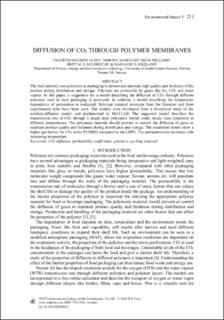| dc.contributor.author | Olsen, Chatrine Høgseth | |
| dc.contributor.author | Augestad, Morten | |
| dc.contributor.author | Helland, Irene | |
| dc.contributor.author | Moldestad, Britt Margrethe Emilie | |
| dc.contributor.author | Eikeland, Marianne Sørflaten | |
| dc.date.accessioned | 2021-09-20T10:48:19Z | |
| dc.date.available | 2021-09-20T10:48:19Z | |
| dc.date.created | 2021-01-05T13:30:45Z | |
| dc.date.issued | 2020 | |
| dc.identifier.citation | Olsen, C. H., Augestad, M., Helland, I., Moldestad, B. M. E., & Eikeland, M. S. (2020). Diffusion of CO2 through polymer membrane. In J. Casares (Red.), Environmental Impact V (bd. 245, s. 211-222). WIT Press/ Computational Mechanics. | en_US |
| dc.identifier.isbn | 978-1-78466-395-7 | |
| dc.identifier.issn | 1746-448X | |
| dc.identifier.uri | https://hdl.handle.net/11250/2779159 | |
| dc.description.abstract | The food industry uses polymers as packaging to protect and maintain high quality and freshness of the product during distribution and storage. Polymers are permeable by gases like O2, CO2 and water vapour. In this paper, a suggestion for a model describing the diffusion of CO2 through different polymers used in food packaging is presented. In addition, a model describing the temperature dependency of permeation is evaluated. Relevant material constants from the literature and from experimental tests have been used. The models were developed from a theoretical study of the solution-diffusion model, and implemented in MATLAB. The suggested model describes the transmission rate of CO2 through a single layer polymeric barrier under steady state conditions at different temperatures. The polymeric material should prevent or control the diffusion of gases to maintain product quality and freshness during distribution and storage. The simulation results show a higher gas barrier for CO2 in the EVOH44 compared to the LDPE. The permeation rate increases with increasing temperature. | en_US |
| dc.language.iso | eng | en_US |
| dc.title | Diffusion of CO2 through polymer membranes | en_US |
| dc.type | Chapter | en_US |
| dc.type | Peer reviewed | en_US |
| dc.description.version | publishedVersion | en_US |
| dc.rights.holder | © 2020 WIT Press. | en_US |
| dc.source.pagenumber | 211-222 | en_US |
| dc.source.volume | 245 | en_US |
| dc.source.journal | Wit Transactions on Ecology and The Environment | en_US |
| dc.identifier.doi | https://doi.org/10.2495/EID200201 | |
| dc.identifier.cristin | 1865586 | |
| cristin.ispublished | true | |
| cristin.fulltext | original | |
| cristin.qualitycode | 1 | |
